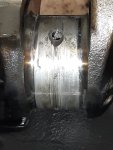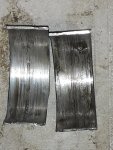L3130-HST. Back-story... there's always a back story. I've owned and (ab)used a B6200 hst for 25 years. Great piece of equipment. My brother purchased a half-section of farmland from an estate. Lock-stock-and barrel The late fellow was known to be somewhat odd, in that he never maintained anything, ran it until it broke and then went to town and bought another. The bushes were full of tractors, trucks, and all manner of stuff, most of which was broken. Three Kubotas, an LX3310, an L3540, and an L3130. The newest one, the LX3310 was still running when the fellow passed away, and within a week thieves went into his yard and took it. The 3540 and 3130 were both non-running and in the bush overgrown so thieves obviously deemed them not worth taking. The 3540 and 3130 were bundled with the land purchase. The 3540 had been sitting at least 5 years since it died and was dragged in the bush, the 3130 sitting in the bush since the 3540 was purchased. The 3540 had been fueled with gasoline, and someone obviously told the old fellow it would need thousands of dollars to make it better, and went to town and bought the LX3310. In fact, the 3540 is now running beautifully after flushing fuel changing fuel filter, changing engine oil twice and HST fluid once. So my brother kept the 3540 for his yard-work, and gave me the 3130.
The 3130 is rumored to have been run out of crankcase oil until it quit running. Hooked a battery to it, and it cranked really really hard and very slowly. Cranked so slowly that it did not seem to make any compression "bump". Kinda behaves like a rod or main bearing starved of oil and tightened up real real bad. Turned engine over a few times, no clanking and banging, no easy or really really tight spots, and no obvious hole punched out in the casting of the block or pan. Unknown hours, did not look at clock when battery was hooked up for experimental crank. The ag-lug tires aren't worn down much, but the edges of the lugs are worn a bit round, and the tires are checked, looking at the tires I guestimate 3000 hrs. When diagnosing an engine by cranking it, a failed-tight bore and piston will turn real hard most of the way around, and there will be an easy-spot where the piston sits still at tdc and bdc. Unless all three bores are equally bad/tight.
So first step in getting 3130 to be a tractor again will be to assess the engine.
Can the oil-pan be removed to remove a few bearing caps and check bearing condition? Or is this like many tractors where the cast iron oil pan is part of the structure of the tractor, and to remove the oil-pan you must split the tractor?
Removing the oil pan is probably somewhat moot anyways. The rumored cause of failure and the behaviour so far indicates some sort of bad internal engine problem that will necessitate grinding the crank, so that means splitting the tractor.
To me, there are two reasons to "split" something like this; 1- to service clutch, where one could leave front of engine and radiator and such all assembled, and remove whats necessary to un-bolt bellhousing from engine block and roll the front away from the back. Thats what I did to replace the clutch disc on my B6200 when the clutch-plate cush-drive springs blew up. That took me about 14 hours from driving into the shop to driving out again.
2- to remove and service engine. Recalling the way the B6200 is structured, to accomplish engine removal I would block up/support the tractor and roll-away the front axle. Then remove the front frame and radiator and stuff. Then support the transmission/rear of tractor and remove engine from bellhousing forward. When I did the B6200 the dash and steering column and operator station did not need removal, I unbolted it and moved it back a smidgen and left it kinda sitting there. I hope I can cheat similarly on the 3130.
I'm expecting to find internal engine damage in and around the crankshaft and bearings. If thats what I find, the "long-block" will go to an engine rebuild shop and come back ready to install. If head, bores, pistons etc are toast and need fixing, the rebuild shop should figure that out. If its the crankshaft, hopefully a grind and 10-over bearings will do it. Maybe a new connecting rod or two.
I'd appreciate any advice from veterans of L-series disassembly, as to how to approach it. I know the WSM sometimes likes to overdo some processes in the interest of idiot-proofing. The B6200 split the tractor process from the WSM recommended removal of rear fenders, floor panels, and operator station/dash. None of which I found to be necessary.
I'm hoping the 3130 can be made better for a few thousand. It came to me basically free. The largest cost in repairing is likely to be the engine rebuild shop and the parts required. Apparently pistons are $400 per, and con-rods $500. Hope I don't need any of those. In these parts, a 3000 hr 3130 with loader would be a $15,000 thing. Hopefully the whole engine does not cost $15,000.
The 3130 is rumored to have been run out of crankcase oil until it quit running. Hooked a battery to it, and it cranked really really hard and very slowly. Cranked so slowly that it did not seem to make any compression "bump". Kinda behaves like a rod or main bearing starved of oil and tightened up real real bad. Turned engine over a few times, no clanking and banging, no easy or really really tight spots, and no obvious hole punched out in the casting of the block or pan. Unknown hours, did not look at clock when battery was hooked up for experimental crank. The ag-lug tires aren't worn down much, but the edges of the lugs are worn a bit round, and the tires are checked, looking at the tires I guestimate 3000 hrs. When diagnosing an engine by cranking it, a failed-tight bore and piston will turn real hard most of the way around, and there will be an easy-spot where the piston sits still at tdc and bdc. Unless all three bores are equally bad/tight.
So first step in getting 3130 to be a tractor again will be to assess the engine.
Can the oil-pan be removed to remove a few bearing caps and check bearing condition? Or is this like many tractors where the cast iron oil pan is part of the structure of the tractor, and to remove the oil-pan you must split the tractor?
Removing the oil pan is probably somewhat moot anyways. The rumored cause of failure and the behaviour so far indicates some sort of bad internal engine problem that will necessitate grinding the crank, so that means splitting the tractor.
To me, there are two reasons to "split" something like this; 1- to service clutch, where one could leave front of engine and radiator and such all assembled, and remove whats necessary to un-bolt bellhousing from engine block and roll the front away from the back. Thats what I did to replace the clutch disc on my B6200 when the clutch-plate cush-drive springs blew up. That took me about 14 hours from driving into the shop to driving out again.
2- to remove and service engine. Recalling the way the B6200 is structured, to accomplish engine removal I would block up/support the tractor and roll-away the front axle. Then remove the front frame and radiator and stuff. Then support the transmission/rear of tractor and remove engine from bellhousing forward. When I did the B6200 the dash and steering column and operator station did not need removal, I unbolted it and moved it back a smidgen and left it kinda sitting there. I hope I can cheat similarly on the 3130.
I'm expecting to find internal engine damage in and around the crankshaft and bearings. If thats what I find, the "long-block" will go to an engine rebuild shop and come back ready to install. If head, bores, pistons etc are toast and need fixing, the rebuild shop should figure that out. If its the crankshaft, hopefully a grind and 10-over bearings will do it. Maybe a new connecting rod or two.
I'd appreciate any advice from veterans of L-series disassembly, as to how to approach it. I know the WSM sometimes likes to overdo some processes in the interest of idiot-proofing. The B6200 split the tractor process from the WSM recommended removal of rear fenders, floor panels, and operator station/dash. None of which I found to be necessary.
I'm hoping the 3130 can be made better for a few thousand. It came to me basically free. The largest cost in repairing is likely to be the engine rebuild shop and the parts required. Apparently pistons are $400 per, and con-rods $500. Hope I don't need any of those. In these parts, a 3000 hr 3130 with loader would be a $15,000 thing. Hopefully the whole engine does not cost $15,000.





